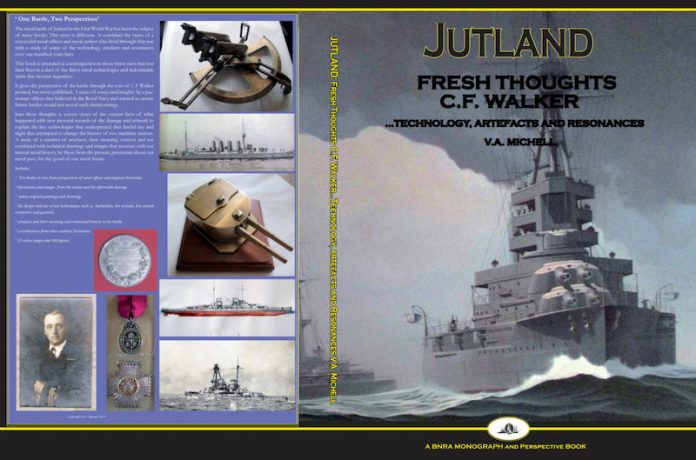
Jutland: Fresh Thought, Technology, Artefacts & Resonances. By C F Walker and V A Michell. Indomitable Press. ISBN: 978 1 9163142 2 1
Reviewed by Bill Evershed
“Don’t confuse me with the facts; my mind is made up!”
Surely anyone with an interest in maritime history is now fully versed in the story of Jutland? Headstrong ‘Young Bull’ Beatty is seduced by shrewd Hipper to meet ‘Mr Big’ Scheer. Not a good meeting. Beatty entices his new acquaintances to meet Sagacious ‘Old Bull’ Jellicoe. Result? German PR victory – first back in Home Ports. German tactical victory – least ships sunk. British strategic victory – Germany doesn’t seek a re-match. Stalemate: certainly no re-run of Trafalgar. And then the ignominy of Scapa Flow.
So why another book about Jutland? Because this does indeed offer fresh thoughts and is effectively two books in one. The first part, of 19 easily readable and illustrated chapters, is compiled from notes made by Commander Charles Walker, a naval historian, who served in the RN from 1914 to 1932 and again from 1939 to 1945. And the second part, of a further 10 chapters, is by Dr Vaughan Michell, the renowned maritime technical researcher and Chairman of the Britannia Naval Research Association.
Cdr Walker did not serve at Jutland: he was but a Midshipman at Scapa Flow in 1919 but he and all his and successive generations up to 1939 were steeped in the lessons and myths of Jutland. All the more surprising therefore that his subsequent penetrating sagacious and scholarly research of Jutland’s lessons and myths did not find favour or earlier acclaim but by then his findings from both British and German sources were already being met by ‘Don’t confuse me with the facts; my mind is made up!’
War purports to be 10% Terror and 90% Boredom. Jutland was 60% Terror and 40% Bewilderment – for both sides. Walker’s binoculars penetrate not only the terror but also peer through the bewilderment of the prevailing sea mist and smoke from funnels, gunfire and action damage to reveal his fresh thoughts. Yes, we too find that both sides suffered from urgent signals, both by wireless and flag hoists, unsent, not received, unread and unreadable. We share the concerns not only of minefields and submarines but of the new-fangled torpedo and air-reconnaissance threats. We are reminded of the Admiralty’s snobbishly inept incompetence with critical Intelligence. Walker’s attention is focussed on debunking the myths. He spices his account with some compelling ’What ifs?’ And alights on the fundamental problem of the RN’s out-dated cordite and its different methods of container and stowage in both Navies.
Dr Michell’s binoculars are interestingly more micro than macro focussed. We meet individuals, discover some of their artefacts, their ships, especially HMS Southampton for which a series of personal album photographs is evidenced, we examine turret evolution and construction, range and direction finding, director control, the development of armour and water-tight sub-compartmentalisation. These 10 chapters are therefore more technically detailed but nicely complement Walker’s observations: Dr Michell’s penultimate chapter ‘A Jutland Error Model’ is sheer brilliance.
Despite my being a post-WW2 sailor, the first capital ships in which I served Newcastle, Vanguard, Sheffield, Bermudaand Belfast were all armoured following lessons learnt at Jutland. An anti-tank missile would have bounced off their hulls. My later, smaller, ships, Brighton, Fearless and the DLG Norfolk were all thin-skinned. And yet Norfolk’s sister ship Glamorgan survived an Exocet missile strike in the Falklands War. But even that is now nearly 40 years ago.
So, what do we learn from all this? Probably no more than we have ever done. We think the next war will start where the last one finished. It never does.
So for whom might this book be recommended? Certainly every member of the BNRA. Then those members of the Naval Review who have an interest in maritime history and especially its strategic, tactical, and technological lessons and development. Directing staff at military and maritime colleges. Universities where maritime research and Defence studies are undertaken. Naval architects at sea-defence-related commercial companies. And the Naval technical planning directorates at the Ministry of Defence. What a tragedy that the RCNC is no more. But above all, for those who do not say “Don’t confuse me with the facts; my mind is made up!”
In short, if your motto is ‘Hit first and go on hitting’ this may be fine. But what if your enemy has the same motto and has a track-record of hitting first?
This review by courtesy of ‘Naval Review’ (UK)



